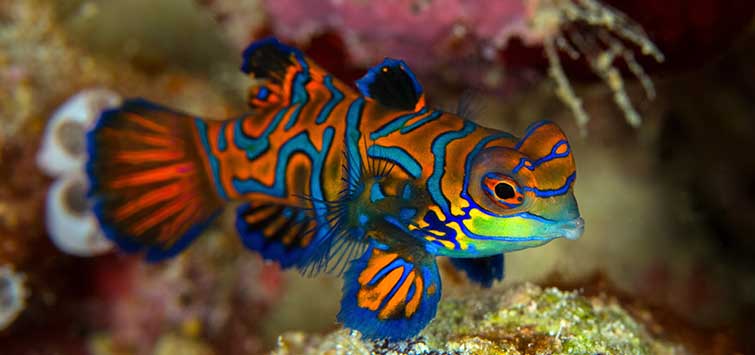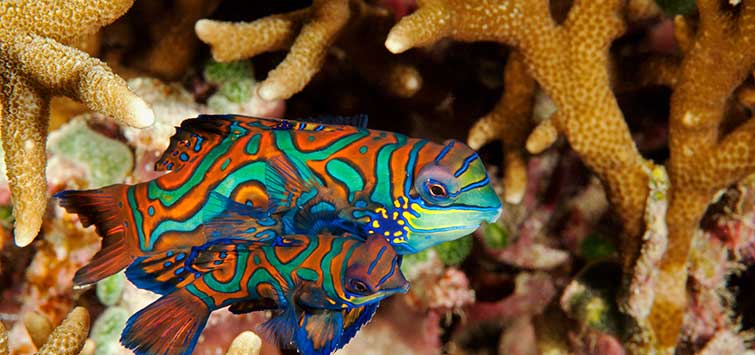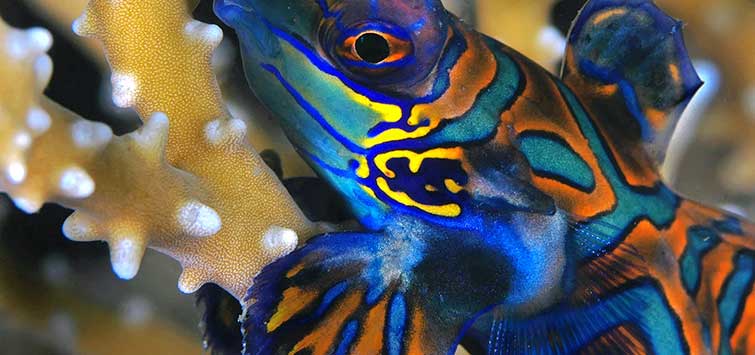A Mandarin Diner
Author: Marc Levenson
One reason mandarins are almost impossible to keep healthy is their picky feeding habits, but with fish conditioned to accept prepared foods in a special feeding station, one aquarist shows how it can be done.
Fall in Love with a Mandarin
Mandarin fish are among the most beautiful of reef-safe fish, and people quickly fall in love with these gentle creatures. They are also quite inexpensive, which gives reefkeepers even more motivation to acquire one. Unfortunately for both the hobbyists and the fish, most mandarins die of starvation soon after they are purchased.
There are various types of mandarins, such as the large blue, red, or green Synchiropus splendidus, and the smaller target or spotted Synchiropus picturatus. These fish hunt for food all day long, picking at the rockwork for tiny invertebrates. They feed throughout the day, and at night they rest.
Success Requires Food
The general advice to successfully meet the needs of one of these fish includes:
· Your reef tank should have already been established for at least six months to one year.
· You need to have a minimum of 75 pounds of live rock.
· There is a much better chance of success if your tank incorporates a working refugium teeming with pods of all kinds.
· Select tankmates carefully. Other pod-eating fish, such as a six line wrasse, are quicker and will consume all the prey before the mandarin has a chance.
Pod Piles
You may get lucky and get a mandarin that eats nonliving foods, but many don’t, so you have to be prepared for your tank to provide all of its food naturally. You can improve your chances by building “pod piles” or hatching baby brine shrimp. A pod pile is a small collection of rocks carefully stacked together so that fish can’t get in between them. Some hobbyists invert a plastic strawberry basket over a pile of small bits of live rock. Fish can’t enter the basket, so the pods can propagate safely. As they emerge from the basket, the mandarin can eat them.
It cannot be the only food source, but hatching brine shrimp is easy and can be done on a rotating basis to provide one new batch each day. Feeding newly hatched brine is more nutritious because the yolk-sac is still attached. So if you want to generate the potential food source with this method, it will work as long as you keep up with your hatcheries.
Having a refugium tied into your system is the best method, since it creates a place where various bugs can breed safely. You will have to feed phytoplankton to your tank and refugium because the copepods, amphipods, and other tiny crustaceans need to eat as well.
The Lucky Ones
You can only keep a mandarin in a smaller tank if you get one that can be trained to take prepared foods. My fish eat small pellet food, mysis, baby brine shrimp, frozen cyclops, and more, but other aquarists find that their fish accept nothing but live prey.
I kept a blue mandarin for a long time in a 29-gallon tank. Much to my delight, it ate prepared foods and was a very happy fish. I then moved it into a 280-gallon reef, and there it was actually being starved due to stress by the other mandarins harassing it, as well as by the voracious tangs that would circle around it and get every morsel off the sand.
The Diner
It became apparent that the fish needed some time alone with the food, which led to my mandarin diner, which I started in November 2004. I used a long empty glass bottle, added the pellets first and then tank water, and gave it a few seconds for the pellets to sink into the bottom of the jar. Then I lowered it into the corner the mandarin tends to visit. The tangs were quite interested in the pellets, pecking at the glass, but they could not fit into the bottle.
Where Did the Buffet Go?
When my mandarin found the food supply after a few minutes, it stayed inside and dined at the all-you-can-eat buffet. About 30 minutes later, the buffet was gone as if it never existed. All that remained were the busboys—a pair of Nassarius snails.
The problem was that the other fish liked that food too, and the smaller tangs could fold up their fins, slip in to get the food, and slide right back out again. My huge naso tang would hover in front of the mouth of the jar and wave its fins back and forth to create current, which would wash the pellets out into the open where it could get them. He was very adept at this!
Solution
After a month of this, I finally bought an olive jar, as that would limit the size of the fish entering the diner. I took a piece of acrylic, heated it, and wrapped it around the jar to act as handle for easy reach on a daily basis. I’ve continued to use a mixture of two types of pellets every day, and the mandarin is almost back to its original plump self. Keep in mind that I also feed newly hatched brine to the tank every day, with the pumps off. This allows the smaller fish the opportunity to eat, and the larger fish just wade through the food like whales.
Finding Long-term Success
Other fish still go in the mandarin diner, including my six-line wrasse, the lawnmower blenny, and blue damsels, but the tangs can only hover near the opening, hoping for stray pellets to drift out. Various snails and hermits go into the diner at night, and each morning I refill it for the new day, with about one teaspoon of pellets. If there is too much food in the jar it tends to rot, and a gas bubble collects in the jar. That is a good indicator of overfeeding, and when it happens, I dump that in the sink and rinse the jar, then next time I cut back on the amount of food.
I have four mandarins in my tank, but the blue ones are the ones that are near the diner constantly. They travel the tank, but know the food is at the diner daily. There are times I’ve lifted the diner with fish in it, dropped in more food and let it back down. Other times I’ll put the loaded jar down on the substrate, and within 10 seconds a mandarin goes right in.
And so the mandarin diner is open for business, and it never lacks for hungry customers. I’m really glad this has worked out so well—and so are my mandarins!

.png?h=595&iar=0&w=2781&hash=5FD5E69473BCC22199FBFA2FB71B6033)



